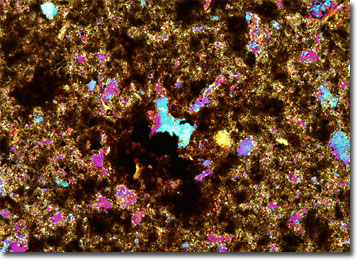Polarized Light Microscopy Digital Image Gallery
Clay Ironstone
Siderite is a common mineral that is a member of the calcite group of related isomorphous carbonates and is often associated with several different metallic ores. Siderite readily alters to iron oxides and is often found in the form of clay ironstone.

Clay ironstone is a fine-grained sedimentary rock frequently described as a concretionary form of siderite. Essentially, the rock is composed of the carbonate or oxide of iron and clay or sand. The color it displays is usually gray, but the outer layers of the material are often brown from oxidation. Relatively heavy, the rock is most often found in the form of nodules, though it also occurs in larger masses that may be flat, round, or lens-like in shape. Many times deposits of the rock are found overlying coal measures. In an economical sense, clay ironstone is generally considered an ore of iron that is of minor significance. However, in Great Britain this rock has been mined considerably and is of more importance than in most other parts of the world.
To some people, the word ironstone is associated with a type of hard bluish-white earthenware that was popular in the nineteenth century. Patented in 1813 by Charles Mason of Staffordshire, England, ironstone china was developed as a more economic alternative to porcelain. Despite its name, however, the pottery was not solely composed of ironstone, although the rock was an important component of Masonís china. In addition to ironstone slag, Mason utilized flint, Cornwall clay, and the blue oxide of cobalt to fashion his popular household items.
